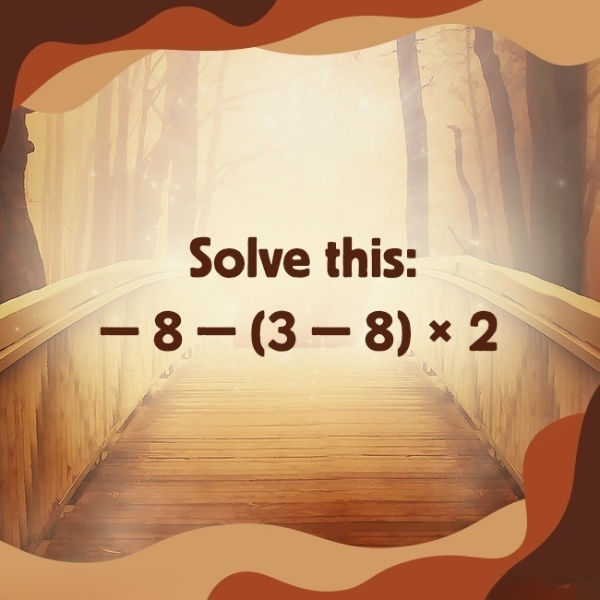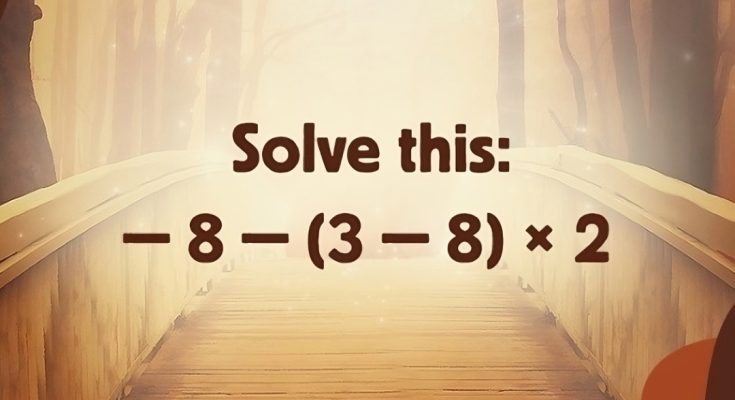Are you ready to put your problem-solving skills to the test? Today’s challenge involves a seemingly simple math puzzle: -8 – (3 – 8) × 2 = ?. While it might look straightforward at first glance, don’t be fooled! Many people stumble upon common pitfalls or overlook key details. Before diving into the solution, give it a shot and see if you can figure it out. Let’s explore how to approach this puzzle and unravel its secrets step by step.

Common Mistakes When Solving Math Puzzles
Math puzzles are designed to challenge your logical thinking, but they often trip people up due to small details. Here are some common errors you might encounter when solving problems like this:
- Ignoring the Order of Operations (PEMDAS/BODMAS): A frequent mistake is solving the equation from left to right without considering the proper order of operations. Multiplication and division must come before addition and subtraction.
- Misinterpreting Negative Numbers: Negative signs and parentheses can confuse even seasoned problem-solvers, leading to incorrect calculations.
- Rushing Through the Steps: Skipping intermediate steps increases the likelihood of errors, especially in problems with multiple operations.
- Overthinking the Problem: Sometimes, simplicity throws people off. Overanalyzing a straightforward equation can lead to unnecessary complexity.
Sound familiar? Don’t worry! We’re here to break it down step by step so you can solve this problem with confidence.
Step-by-Step Solution to -8 – (3 – 8) × 2
Let’s tackle this problem systematically, using the order of operations (PEMDAS: Parentheses, Exponents, Multiplication and Division, Addition and Subtraction). Here’s how to solve it:
Step 1: Solve Inside the Parentheses
Start by resolving the expression within the parentheses. In this equation, we have:
(3 – 8) = -5
Now the equation becomes:
-8 – (-5) × 2
Step 2: Perform Multiplication
Next, handle the multiplication. Multiply -5 by 2:
-5 × 2 = -10
Substitute this result back into the equation:
-8 – (-10)
Step 3: Handle the Subtraction of a Negative Number
This step often trips people up. Subtracting a negative number is equivalent to adding its positive counterpart. So:
-8 – (-10) becomes -8 + 10
Step 4: Perform the Addition
Finally, add -8 and 10:
-8 + 10 = 2
The Correct Answer: 2
If you followed the steps correctly, your final answer should be 2. Congratulations if you got it right! If not, don’t worry—understanding where mistakes happen is part of the learning process.

Why This Problem Causes Confusion
Even simple-looking problems like this can stump us. Let’s break down why this equation is so tricky:
- Double Negatives: Subtracting a negative number isn’t something most of us encounter daily, so it’s easy to forget that it turns into addition.
- Order of Operations: Skipping over the multiplication step and solving left-to-right can lead to incorrect answers.
- Mental Shortcuts: Trying to solve the equation in one step rather than breaking it into smaller parts can result in errors.
Understanding these common pitfalls can help you avoid them in the future.
The Value of Math Puzzles
Math puzzles aren’t just about solving equations—they’re a great workout for your brain! Here’s why you should embrace them:
1. Sharpen Your Logical Thinking
Puzzles force you to follow structured steps and think critically, which can improve your problem-solving skills in real-life situations.
2. Improve Attention to Detail
One small mistake can change the outcome of a problem. Puzzles train you to focus on the finer points and double-check your work.
3. Boost Mental Agility
The more puzzles you solve, the faster and more efficiently you’ll be able to tackle complex problems.
4. Encourage Patience and Persistence
Solving a tricky equation can be frustrating, but pushing through the challenge teaches patience and resilience.
Let’s Hear From You
Did you figure out the answer to -8 – (3 – 8) × 2 = ?? Whether you got it right or made a mistake, we’d love to hear your thought process! Share your answer and how you approached the problem in the comments below.
Also, if you enjoyed this puzzle, why not challenge your friends? It’s a fun way to test their problem-solving skills and spark a friendly debate about who can solve it fastest.
Conclusion: Keep Challenging Your Brain
Math puzzles like this one are more than just games—they’re a way to sharpen your mind and develop essential skills. Whether you nailed the solution or learned something new from a mistake, the journey is what counts. With each puzzle you solve, you’re strengthening your ability to think critically and tackle challenges head-on.
So, don’t stop here! Explore more brain teasers, riddles, and tricky equations to keep your mind sharp and engaged. Who knows? The next problem might be your chance to shine as a math whiz. Happy puzzling!



